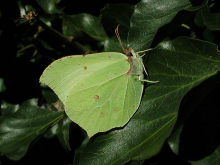
Widespread


Distribution and Status
Habitat Requirements
Almost anywhere in the wider countryside although in the early spring they are more likely to occur in wooded areas where most adult specimens hibernate
Larval Foodplants
Alder Buckthorn Frangula alnus, Purging Buckthorn Rhamnus catharticus. [Curled Dock Rumex crispus , Dogwood Cornus sanguinea]
Adult Food Sources
Buddleia Buddleja davidii, Wild Teasel Dipsacus fullonum , Runner bean Phaseolus coccineus
Behaviour/Observation notes
The Brimstone is more active in the spring when both sexes seek out a mate. Males spend time patrolling hedgerows and woodland edges to search for females which generally emerge from hibernation later. Because of the more frenetic activity of the butterflies at this time they are more difficult to approach. However, after mating has occurred, males spend more time feeding and females egg-laying, facilitating an easier approach for close-up photographs

Life History
This species can be seen in every month of the year as it overwinters as an adult. It is most active in the spring when peak numbers usually occur in April. The hibernating individuals may even be flying in early July when the emergence of the new generation begins. The eggs are usually laid singly under a buckthorn leaf in early May with caterpillars hatching out by the end of the month. When larvae are fully grown they usually pupate away from the foodplant. Just before emergence of the adult butterfly, a spot on the forewing can be seen through the pupal case
Further information
Photo gallery
Branch Annual Report (2022)
UK distribution map
Full list of larval hostplants (Pieridae)
Stevenage butterflies - additional notes